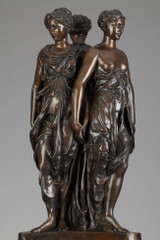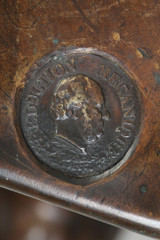An important bronze group with a nuanced brown patina depicting three women, back to back, dressed in light tunics, their hands clasped, seemingly forming a slow, deliberate circle. The measured elegance of their gestures, the serenity of their expressions, and the regularity of their faces evoke antiquity. This bronze rests on a tripod base with rich Renaissance-inspired decoration and a red velvet plinth. It was made at the end of the 19th century, after the monument to the heart of King Henry II, executed by Germain Pilon in the 16th century. It bears the mechanical reduction mark A. COLLAS. The bronze was probably made by Barbedienne. There is a slight crack on one neck. Dimensions of the bronze without the plinth: W: 45cm, D: 40cm, H: 96cm. Dimensions with the plinth: W: 45cm, D: 40cm, H: 103cm. The monument to the heart of Henry II was commissioned in 1561 by Catherine de Medici for her late husband. Placed in the church of the Celestines convent in Paris, it was intended to house the hearts of the King and Queen of France. Germain Pilon sculpted the group of Graces, and the Italian Domenico Florentino created the triangular base. The group of Graces is inspired by an ancient group of the triple Hecate. It also evokes a cassolette designed by Raphael for Francis I and engraved by Marcantonio Raimondi. For the ancient Romans, the Graces symbolized marital fidelity. The inscriptions on the base, which commemorate the unbreakable union of the two spouses, support this interpretation. The monument thus legitimizes Catherine de Medici's political role in governing the kingdom. The original marble version is kept at the Louvre Museum. Germain Pilon (Paris, c. 1528–1590) is one of the most important sculptors of the French Renaissance. He sculpted the tombs of the French kings of the 16th century. The son of sculptor André Pilon, he learned terracotta modeling and stone carving from his father. Appointed Controller of the King's Hallmarks and Coins, he also learned the art of bronze casting and chasing. From 1558 until his death, he worked for the French court, creating the funerary monuments of Francis I and Henry II, the recumbent effigies of the latter and Catherine de Medici, as well as the royal coins. He was also a sculptor appreciated by the French aristocracy, again specializing in funerary art. Bibliography: Database of works in the Louvre Museum. http://www.louvre.fr/oeuvre-notices/monument-du-coeur-d-henri-ii Period: Late 19th century, Circa: 1880 Dimensions: W: 45cm, D: 40cm, H: 102cm.
- Reference :
- 2227
- Availability :
- Sold
- Width :
- 45 (cm)
- Height :
- 102 (cm)
- Depth :
- 40 (cm)
- Identify Exists:
- False






















